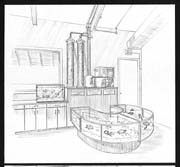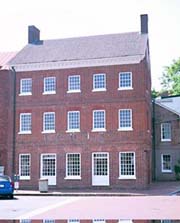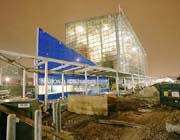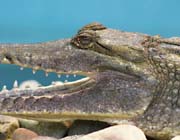 |
||
|
||
Evolving Our Cultural LandscapeSix Chesapeake Destinations You’ll Want to Visit in 2006 ~ by Carrie Steele Chesapeake museums, galleries and centers are greeting the new year with hammers, blueprints and demolition paving the way to change. Evolving our cultural landscape means newer and, designers hope, more meaningful ways for us to experience Bay life. Such changes will likely be around for generations, giving us better access to the Bay’s history, life and community — and, in the National Aquarium’s case, the chance to travel across the world. Shaking up our familiar landscape this year are six Chesapeake destinations that have lobbied, schemed and drawn plans to catch your eye — and make a new mark in our heritage. Preview them now, from Solomons to Baltimore: Hands-On the Bay at Calvert Marine MuseumYoungsters get a new space for discovery |
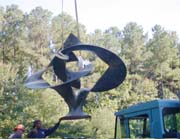 |
|
One of seven sculptures from D.C.’s Hirshhorn Museum is unloaded at Annmarie Garden, where a team of conservators will restore the artworks before they go on display. |
Annmarie Garden is cultivating its collections outdoors and indoors to bring more and more diverse forms of art to the 30-acre garden.
Annmarie is already an Eden of outdoor art hidden away at the tip of Calvert County. Four years ago, the young garden moved into the big time, affiliating with Washington, D.C., Hirshhorn Museum and Sculpture Garden, the Smithsonian avant-garde art institution. This year, seven more Hirshhorn sculptures joined the first 10 at Annmarie. The giant sculptures arrived by flatbed 18-wheeler truck in November, and a team of conservators set on them with blowtorches and soft brushes to remove corrosion and to restore the surfaces.
Six of these renewed metal giants have already joined Annmarie’s outdoor collection of local and world-class sculpture, with one still waiting on its restoration to again face the elements.
Since Annmarie Garden became a member of the Smithsonian Institution Affiliations Program in 2001, it routinely hosts visiting sculptures, which often come in need of cleaning and refinishing. For that job, Annmarie Garden hires Smithsonian-approved restorer Andrew Baxter from Richmond. Baxter then repatinates the statues, many of which need a new surface after enduring years of harsh elements.
“It’s an excellent way for sculptures to have life outside of the Hirshhorn,” says Gabriel Einsohn, of the D.C. museum which owns some 11,500 works — including sculptures that weigh several tons. “They can be enjoyed rather than be in dark storage.”
These seven are just the newest group of installments that Annmarie Garden’s director Stacy Hann-Ruff expects will multiply yearly.
With its outdoor collection ever growing, Annmarie is lobbying closer to home for an indoor art space.
“It’s going to give us much more flexibility in what we do,” says Hann-Ruff of an even bigger change she hopes is coming her way. The proposed 12,000-square-foot gallery — adding an area equal to 15 times the 800 square feet of existing indoor space — will be a multi-use building for hands-on programs, exhibits and receptions.
Nature is great for art, but a roof keeps out the rain. And with ArtsFest, Annmarie Garden’s arts extravaganza, attracting some 15,000 visitors each year, this new space would suit artists who can’t exhibit outside, furniture-makers, for example, and artists who work in paper.
Planners Wheeler, Goodman, Masek and Associates of Annapolis drew up a pretty simple building, says Hann-Ruff. Its prefab structure helps keep costs down, but architect Ed Masek and his team will make it artsy. Keeping with local flavor and culture, the designs call for a building shaped like the hull of a boat, with the bow and stern in glass, ideal for displaying big sculptures.
About exhibits in the new gallery — which would come and go — Hann-Ruff is bubbling with ideas. The Smithsonian rents out traveling exhibits, and Calvert Marine Museum might be a partner in mounting complementary exhibits. Collaborating with the Arts Council of Calvert County would bring in even more local art.
But it’s the interactive exhibits that have gallery staff daydreaming. “We saw one where someone had taken a screen door and made a maze — and you could enter the art by opening and closing doors to navigate the maze,” she recalls. “That really makes art approachable.”
The Garden has always wanted a gift shop, Hann-Ruff says, and with the new space they’d not only get their gift shop, they’d have room for a small café as well.
With the building plans already drawn up, all they need is a million dollars to complete their budget for the $3 million gallery. The Garden is owned by Calvert County but is managed by the Koenig Private Foundation, which donated the land in memory of Annmarie Koenig and has already raised $2 million for the new building. Hann-Ruff hopes to fill in the third million this winter from the county and the state.
If the county commissioners say yes, Hann-Ruff says, “we plan to break ground this year.”
Annmarie Garden is located in Solomons, just off Route 4 on Dowell Road. The Garden is open daily, 9am to 5pm and admission is free: 410-326-4640; www.annmariegarden.org.
New Digs at Historic London Town
In historic town, new construction takes a little longer
At Historic London Town and Gardens, the modern-day visitor center that will help visitors make sense of the community of historic 1700s buildings and colonial archeology is behind schedule. Built on the old foundation of the abandoned Woodland Beach wastewater plant, this jumping off point for history was slated to open its doors in August of 2005.
Now, London Town expects to roll out the welcome mat by spring of 2006 for the $5.35 million, partially underground building. After the ribbon cutting, students of history will be able to use the classrooms and orientation areas. Exhibits won’t be installed until September.
“It’s been slightly delayed, but we’re anticipating a March completion and ribbon cutting,” says Donna Ware, director of Historic London Town and Gardens, who hopes both Gov. Robert Ehrlich and county executive Janet Owens will cut the ribbon.
Delaying the opening was “some mechanical equipment that was on order and that slowed everything down,” she says.
That’s normal, a patient Ware continues, for a project of this size. The two-building 12,000-square-foot underground center with a living, green roof at ground level to retain stormwater runoff is the work of the Baltimore architectural firm Cho Benn Holback and Associates Inc.
One of the construction challenges is converting an underwater wastewater plant into a museum, says Pam Jordan, spokeswoman for Anne Arundel County, which owns Historic London Town and Garden.
The new center not only recycles the foundation of a wastewater site that’s been out of use since 1987; it also incorporates green building practices.
Once doors open, visitors will find an orientation center, a museum explaining London Town’s role in colonial transportation, a classroom and the Anne Arundel County archaeology lab.
Despite the wait, “the budget set at the beginning of the project is right on target,” Ware says.
HistoryQuest Journey Nears the
End... and Beginning
Opening on Maryland Day, a place where city history starts
Toe the waters of Annapolis’ history no more. After March 24, history travelers — and out-of-town-guests — can jump into the city’s past with a stop by the Historic Annapolis Foundation’s new HistoryQuest center.
HistoryQuest at the St. Clair Wright History Center — named for Anne St. Clair Wright, a co-founder of Historic Annapolis Foundation in 1952 and a driving force in Annapolis preservation — is both a destination and a waypoint.
On a first floor, find out where and how to take glimpses or day-long tours of Annapolis history over the eras. With the new center comes a new audio walking tour, now in the form of a digital playback system holding 84 sites you can visit in any quantity or order you choose. You’ll also get a themed map, which takes you without any specific routes to Civil War sites, African American sites, Revolutionary sites and more.
On the second, find an eight-minute movie and half a dozen exhibits.
“The film brings the sites to life,” says HistoryQuest’s manager, Patricia Blick. “Sometimes when you see a site, it’s hard to imagine living at that time.”
The historic short travels in time and space, visiting nearby historic sites, staged historic scenes (like a lavish Golden Age dinner party at the Hammond Harwood House) and up-close, narrated glimpses of artifacts from Annapolis to Southern Anne Arundel County.
Exhibits featuring a tasting of artifacts from the museum’s collection — of some 1,414 decorative and fine arts objects; 680,000 archaeological artifacts and 878 plants, plant groups and tools — illuminate major phases of Annapolis history: from early settlement through the Golden Age, Revolutionary era, the post-Revolution to early 20th century and through the present.
But before you can get onboard at the restored early 1790s brick building at the foot of Main Street, a few exhibits still must be finished.
Over Christmas, contractors completed the addition of an elevator that satisfies 21st century safety while retaining historic authenticity, says the Foundation’s Sarah Elder.
“We did everything we could to maintain what we think it was,” says Elder. Annapolis has more restored historic properties than any other city in the United States — even Williamsburg. That’s why, “we’re taking our time to make sure we do it right,” she says.
“Right now it’s a just big, lovely, empty building,” Elder says. Installation of exhibits should begin at the end of January.
On March 24, Maryland Day, a ribbon-cutting and grand opening ceremony officially open this downtown time machine.
Maryland Hall Hopes to Make a Grand Entrance
A new road to art advances
A wider entry road for Maryland Hall for the Creative Arts has been moving forward with baby steps since the last century.
The plan would widen Greenfield Street at Spa Road to accommodate the daily load of the city’s art center and Bates Middle School next door. Maryland Hall is the former Annapolis High School, and both properties belong to the Anne Arundel County Board of Education.
“It’s been a traffic bottleneck since I’ve been here, which is 40 years,” says Linnell Bowen, Maryland Hall’s executive director and a former student and teacher at Annapolis High School. “It’s a busy place. I’m concerned about safety for student and patrons.”
Plans call for expanding Greenfield Street to include a third lane to open up the traffic bottleneck by enabling a left-hand turn onto Spa Road from Maryland Hall. Arriving at Maryland Hall would also be grander. Instead of turning down a side street, you’d know you’re in for something big as you turn off of Spa Road onto the new Greenfield Street.
“There’s still some things that have to be done,” says planning and zoning director Jon Arason of approvals and decisions that precede any groundbreaking. Just before Christmas, the school board surplussed the property to the county council, moving the plan another step forward.
The construction bottleneck could ease up as early as this year, as development transforms nearby Spa Road. In the works is a three-way deal: As Carraway Properties constructs residences, they’ll widen the road, which will ease traffic for Maryland Hall and Bates Middle School as well as make way for residents. Developers have to build roads to access their projects, says Arason, and the city has roads standards.
The next step will be an agreement between the City of Annapolis, the developer and the board of education. Arason expects that Annapolis will fund some 40 percent of the project, with the majority — some 60 percent — coming from the developer.
The joint project means that the city will be widening Greenfield Street, with Public Works overseeing the construction, Arason says.
“It’s really a win-win situation,” says Bowen.
The developer is Carraway Properties’ Jeff Carraway, who’s planning the Spa Gate development, 13 new townhouses lining both sides of the new Greenfield Street to replace the 13 condemned homes off Spa Road, plus six units more behind those. Carraway would oversee the construction of the new road, Arason says.
The new development, however, isn’t good news for some neighbors, who have raised concerns about already present drainage issues in the community, says city spokeswoman Jan Hardesty.
But Maryland Hall has high hopes for the project getting under way in 2006 and is already beginning to daydream of ways to grow their native landscaping theme into this new threshold.
Until then, it’s a ream of paperwork and a Blackberry full of meetings.
“There are so many components of this,” says Hardesty. “That’s why it’s taken so long.”
At 25, National Aquarium Goes Down Under
Australia’s aquatic and aviary creatures settle in Baltimore
If you think you’ll never trek through a rocky river-gorge in the outback wilderness of Australia, where fire and flood ravage the landscape, think again. At the new wing of the National Aquarium in Baltimore, you pass a 35-foot waterfall, a cubby of lizards, a smattering of Aboriginal drawings, through a revolving door — then you’re swept into Animal Planet Australia: Wild Extremes.
Filling the giant all-glass atrium is habitat for Australian lizards, crocodiles, fish, fruit bats, parrots and more.
Three years of construction brought a new front entrance to the aquarium, where a plummeting waterfall greets you in the foyer. You’ll notice big changes inside as well as out.
“This exhibit is like a lantern for the Inner Harbor,” says Mark Donovan, director of exhibits and design. Donovan was one of three Aquarium staffers who traveled through Australia — a continent about the same size as the United States — to conceive the Down Under exhibit.
Aquarium designers have filled their 64,500-square-foot glass expansion with hand-carved red rocks modeled after the ones lining a river gorge in Australia’s Northern Territory. As you wander the exhibit’s riverbed (don’t worry, designers parted the waters for you), keep your eyes peeled for a sight of 20 free-roaming lizards.
Don’t expect kangaroos or koala bears. Aquatic and aviary creatures rule in this collection that includes 1,800 fascinating animals of 120 species to mesmerize visitors of all ages.
Freshwater crocodiles, frilled lizards, fruit bats, snake-necked turtles and spiny-tailed monitors — all some 10,000 miles distant from their native land — swim, fly and climb around you. It’s the biggest collection of this type in the country, says Donovan. Chest-level tanks wind around either side of the path, where you can examine fish, turtles and crocodiles swimming just inches away behind glass.
Meander through the exhibit slowly, taking in the scene created by extreme forces of nature: a tree that’s scorched by fire across from a collection of debris above the river, represented in six different clear tanks framed by realistic-looking sandstone.
There’s also a human side of the exhibit: faux aboriginal art on the sandstone takes you back 50,000 years.
The exhibit is part of a $74.5 million expansion that makes up a new wing of the building, including cafeteria, gift shop and foyer. The main financial sponsor of the new exhibit was the cable channel Animal Planet, but funds also came from the Aquarium’s capital campaign, individual donors and state money.
Included in the $74.5 million project are a handful of outdoor gardens: room-sized Chesapeake habitats like a mini-salt marsh, planted with native plants, in sight of all passersby.
A nice entrance, but the real excitement is inside.
Jeff Corwin, animal expert and guide on a preview of the exhibit, summed up the Aussie addition: “Most people in this area are never going to go to Australia; here, they can get the experience.”
And not just once in a lifetime.
“You can’t come just once,” he says. “Every time I come through, I spot something new.” He looks up and points to a lizard lounging on a rock above his head.
The National Aquarium in Baltimore’s Inner Harbor is open daily 10am to 5pm and Fridays 10am to 8pm. Avoid lines by buying tickets online before you visit. $21.95 w/discounts; $5 Fri. after 5pm: 410-576-3800; www.aqua.org.

